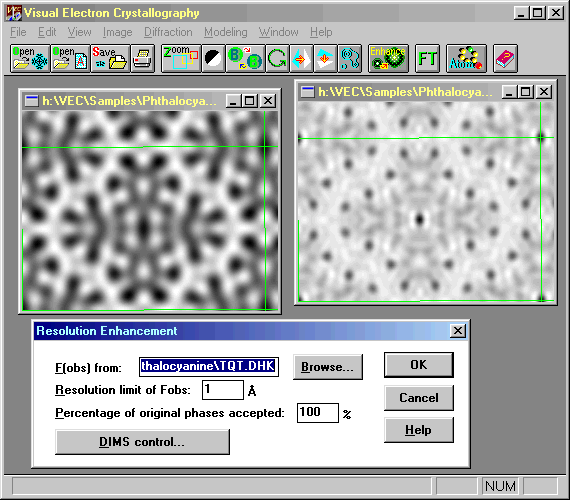Resolution enhancement via phase extension
Sample: copper chlorinated phthalocyanine
Space group: C2/c
Unit cell parameters: a=19.62, b=26.08, c=3.76Å and
b=116.5o
Unit cell contents: Cu 2
Cl 32 C 64 N 16
The operation should started from a deconvoluted image
(see "Image deconvolution").
In the present example, the deconvoluted image of the sample is shown in the upper-left
sub-window in the following figure. Let it be the current window and click the button
 . Two dialog boxes will appear succesively. The first one asks for unit-cell contents.
The second one is shown in the sub-window at the bottom of the following figure. Put in the
full path of the diffraction-data file. This file should have an extension
'.dhk'.
The user would input also the 'Resolution limit of Fobs', the value of
which is usually 1Å The enhanced image will then appear as shown on upper-right of
the figure below. .
. Two dialog boxes will appear succesively. The first one asks for unit-cell contents.
The second one is shown in the sub-window at the bottom of the following figure. Put in the
full path of the diffraction-data file. This file should have an extension
'.dhk'.
The user would input also the 'Resolution limit of Fobs', the value of
which is usually 1Å The enhanced image will then appear as shown on upper-right of
the figure below. .

There is a button "DIMS control..." in the second dialog box.
DIMS is a direct-method
program. There are two versions of DIMS in VEC. One is merged with other VEC functions,
while the other is stand-alone. The former is now
used to perform the phase extension for conventional structures. There are
many controlling parameters for this process. If you know something about direct methods and
wish to modify the default control, then click the "DIMS control" button and play with the
upcoming dialog box.
 . Two dialog boxes will appear succesively. The first one asks for unit-cell contents.
The second one is shown in the sub-window at the bottom of the following figure. Put in the
full path of the diffraction-data file. This file should have an extension
'.dhk'.
The user would input also the 'Resolution limit of Fobs', the value of
which is usually 1Å The enhanced image will then appear as shown on upper-right of
the figure below. .
. Two dialog boxes will appear succesively. The first one asks for unit-cell contents.
The second one is shown in the sub-window at the bottom of the following figure. Put in the
full path of the diffraction-data file. This file should have an extension
'.dhk'.
The user would input also the 'Resolution limit of Fobs', the value of
which is usually 1Å The enhanced image will then appear as shown on upper-right of
the figure below. .
